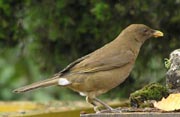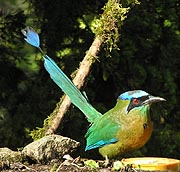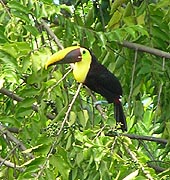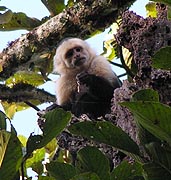| Feb. 25 : In the morning, we will walk another of
Carara's trails before taking a boat trip on the Rio Tarcoles to find
American Crocodiles, herons, egrets, shorebirds and mangrove species. This
is often a major highlight of the tour for many participants. Back at our hotel, an optional late-afternoon walk will be conducted. As darkness falls, we will search for owls and other night creatures. B/L/D. Ov. Hotel Pochote Grande. |
|
| Feb. 26 : Optional early morning bird walk around the hotel. After breakfast, we leave along the coast road for the Pacific lowland resort of La Cusinga. A short stop enroute will be made at Manuel Antonio National Park before reaching the beautiful location of La Cusinga, where we will hike through the grounds until dusk. Many animals and birds can be found here in this idyllic setting. B/L/D. Ov. La Cusinga Resort. | |
| Feb. 27 : After breakfast, we will walk the
lodge trails. Then down to the lovely Pacific Ocean and the adjacent
Ballena National Park, where seabirds, dolphins, whales and other marine
life can be seen. Time for swimming and snorkeling. After a picnic lunch,
we drive to Hacienda Baru Nature Reserve near Dominical. A canopy tower
will be visited, then we will walk a trail into the mangroves searching
for birds and animals. B/L/D. Ov. La Cusinga Resort. |
|
| Feb.28 : Today we visit 2 distinct habitats : in the morning, the Pacific lowlands at La Merced Reserve; in the p.m., the rainforest highlands of the Oro Verde Nature Reserve. Many bird species will be seen as well as animals, butterflies, and plants. In 2005 La Merced species included Red-legged Honeycreeper, Slaty-tailed Trogon, Green Kingfisher, Lineated Woodpecker, Golden-hooded and Cherrie's Tanagers, Scaled Pigeon, White Hawk, Gray-headed Kite, and Mangrove Black Hawk. B/L/D. Ov. La Cusinga Resort. |
|
| March 1 : Optional pre-breakfast walk on the La Cusinga
trails. Then we head for San Vito and the Wilson Botanical Gardens (Las
Cruces) close to the Panamanian border. Here the numerous trees, bushes,
flowers, orchids, and ferns are well worth the visit alone. But there are
several interesting trails and rainforest walks which will produce many
birds and animals. Rare species to be sought include Little Tinamou, Ruddy
Quail-Dove, Rufous-tailed Jacamar, Brown-billed Scythebill, Bicolored
Antbird, Black-faced Antthrush, Turquoise Cotinga and Thrushlike Manakin. B/L/D. Ov. Wilson Botanical Gardens, San Vito. |
|






